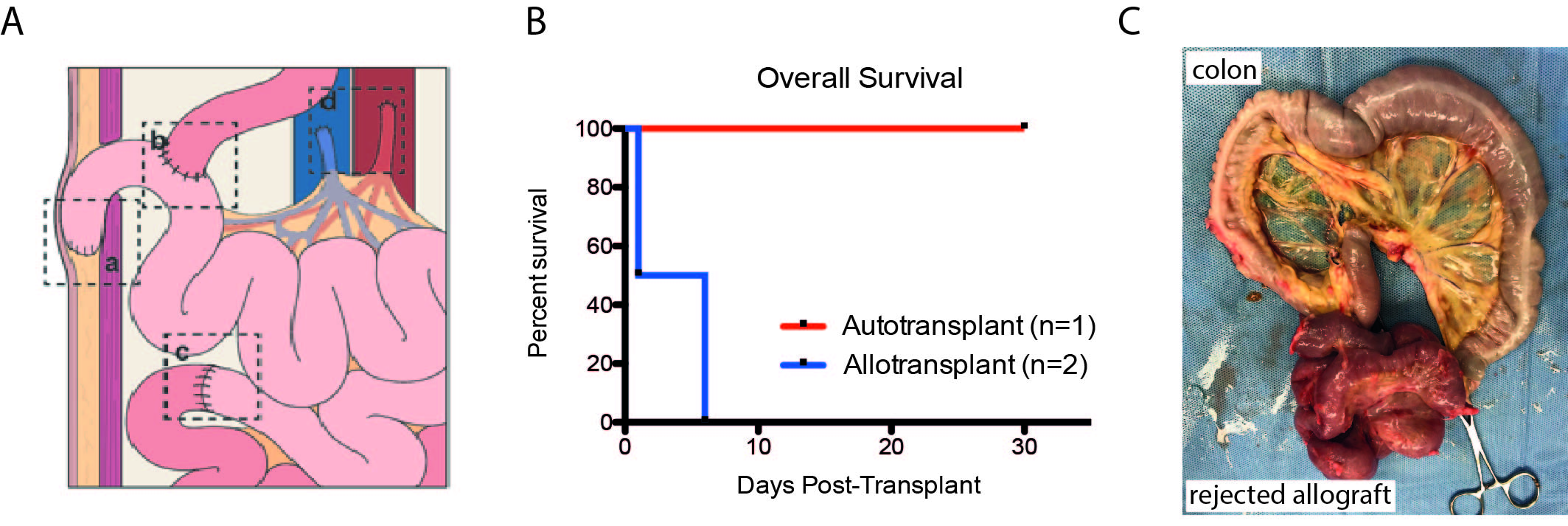A Nonhuman Primate Model of Intestinal Transplantation – Technical Aspects and Early Outcomes
1Department of Surgery, Duke University Medical Center, Durham, NC, 2Department of Biomedical Engineering, Duke University, Durham, NC
Meeting: 2020 American Transplant Congress
Abstract number: 305
Keywords: Intestinal transplantation, Preclinical trails, Radiologic assessment, Rejection
Session Information
Session Name: Intestinal Transplantation
Session Type: Oral Abstract Session
Date: Saturday, May 30, 2020
Session Time: 3:15pm-4:45pm
 Presentation Time: 4:27pm-4:39pm
Presentation Time: 4:27pm-4:39pm
Location: Virtual
*Purpose: Intestinal transplantation (IT) is the treatment of choice for patients with irreversible intestinal failure that experience complications from total parenteral nutrition. Long-term outcomes after IT have improved; however, high rates of rejection and immunosuppressant-related complications remain opportunities for improvement. To investigate these challenges, we have developed a model of IT in nonhuman primates.
*Methods: Three rhesus macaques underwent orthotopic IT. The first primate underwent an autotransplantation to establish our surgical technique. After successful autotransplantation, two MHC mismatched primates underwent swapping allotransplantation. Primates did not receive immunosuppression. Protocol intestinal biopsies were performed on day 3 and 7 after transplant from a defunctionalized limb of proximal jejunum (Figure 1A box a). Additionally, optical coherence tomography (OCT) was utilized for minimal-invasive surveillance of the graft. Recipient and donor lymph nodes were analyzed at the time of transplant and necropsy. Peripheral blood mononuclear cells were analyzed by flow cytometry throughout the study period.
*Results: Intestinal autotransplantation was tolerated well with long-term graft survival (>6 months) and without significant weight loss after transplantation (Figure 1B). In the allotransplantation group we experienced one graft loss due to SMA thrombosis. In the absence of immunosuppression, the second primate experienced graft rejection on postoperative day 6 (Figure 1C). We were able to sample graft biopsies from a defunctionalized loop of bowel during the study period. Optical coherence tomography (OCT) was able to detect structural changes in the bowel wall that correlated with graft rejection.
*Conclusions: Orthotopic intestinal transplantation is technically feasible and well tolerated in a nonhuman primate model. Our model facilitates preclinical studies for surveillance, prevention and treatment of rejection after intestinal transplantation. OCT has shown potential and detecting graft rejection without the need for a tissue biopsy.
To cite this abstract in AMA style:
Schmitz R, Yoon J, Song M, Jelly E, Wax AP, Knechtle SJ, Sudan DL, Kwun J. A Nonhuman Primate Model of Intestinal Transplantation – Technical Aspects and Early Outcomes [abstract]. Am J Transplant. 2020; 20 (suppl 3). https://atcmeetingabstracts.com/abstract/a-nonhuman-primate-model-of-intestinal-transplantation-technical-aspects-and-early-outcomes/. Accessed December 12, 2025.« Back to 2020 American Transplant Congress

